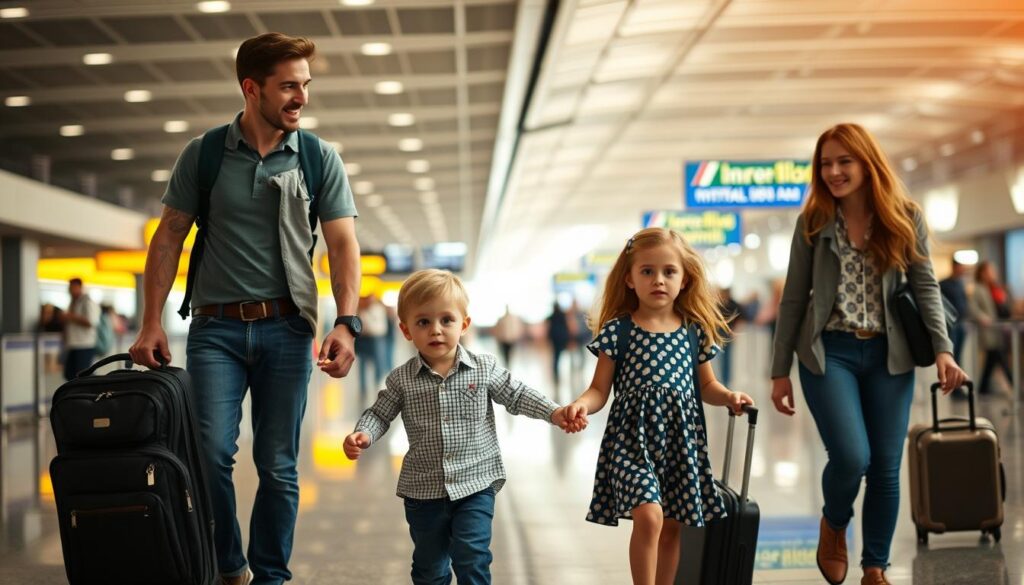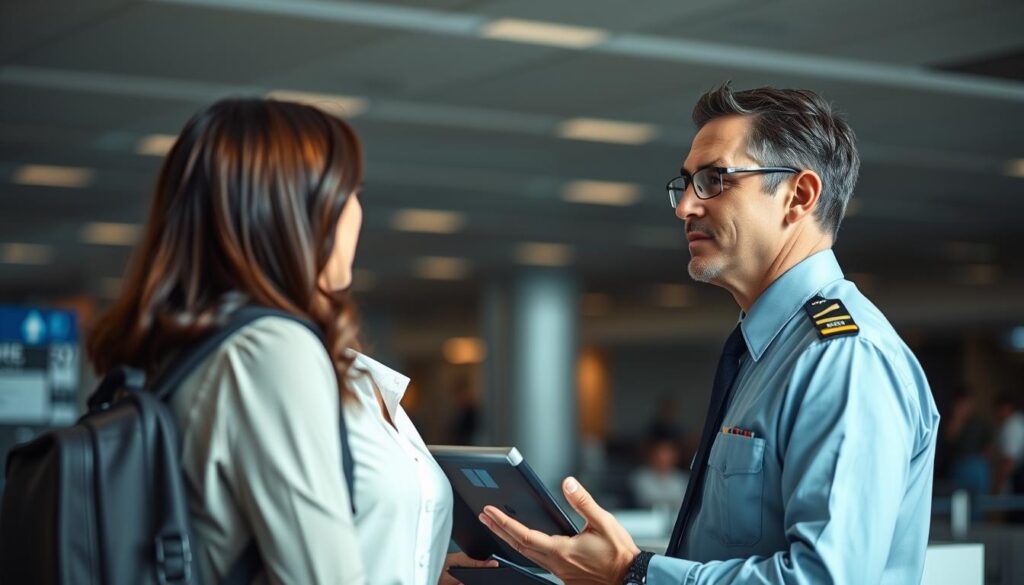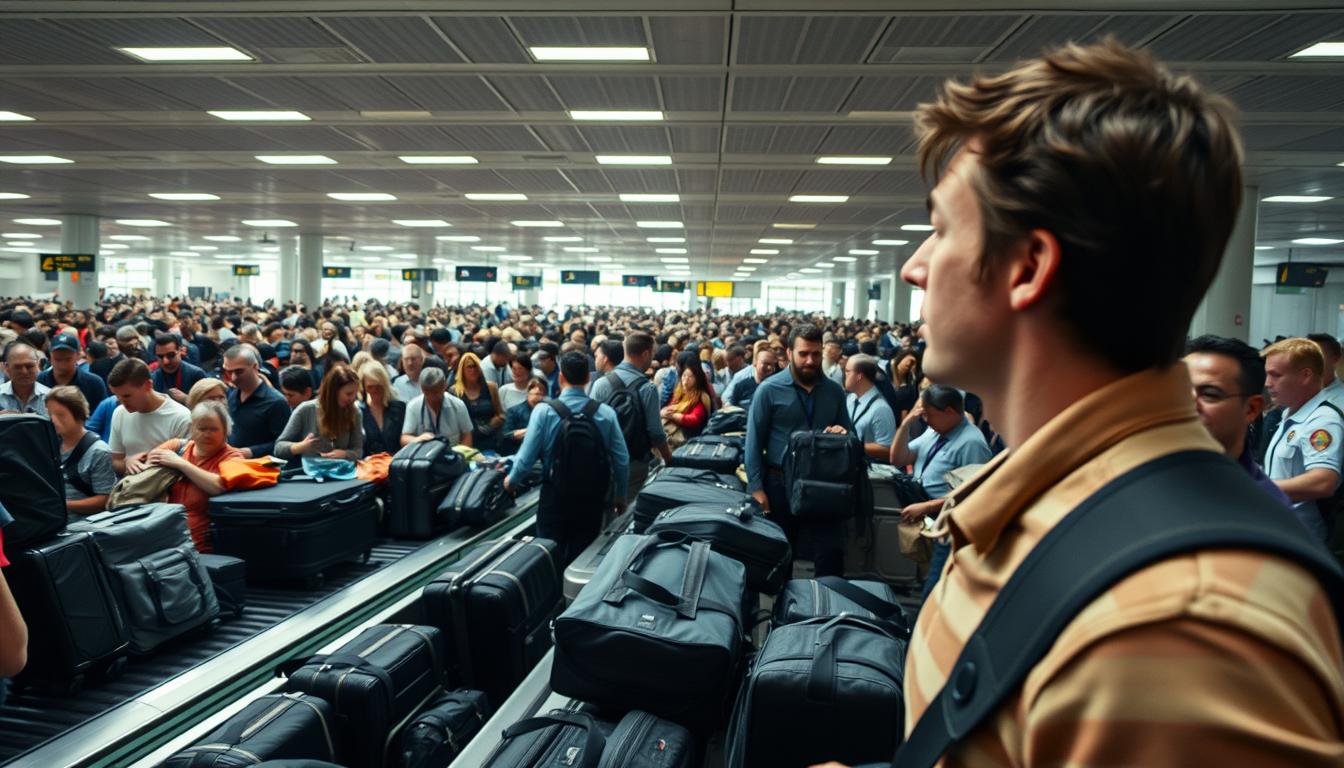Anúncios
Ever thought a well-packed carry-on could make immigration stress-free? Knowing the right immigration travel tips is key, especially with a baby. Packing your carry-on right can make your journey smoother, keeping essentials handy and making the process quicker.
Let’s look at how to pack smart for immigration, especially with a baby. By following these tips, you can reduce stress and increase comfort. This way, you can enjoy your arrival without worry. We’ll cover the essential steps to pack your carry-on well, ensuring a smooth experience at customs and immigration.
Anúncios
Understanding Immigration Procedures
When you travel internationally, knowing the immigration steps can make your arrival in the U.S. better. You’ll need to go through several checks and fill out forms. These are required by customs regulations.
First, you’ll check your documents at the gate. Officials will look at your passport and visa. Then, when you get off the plane, you’ll go through immigration checks.
Here, Customs and Border Protection (CBP) will review your info. You’ll need to show your ID and answer some questions. Keeping your documents ready can make things easier. If you’re traveling with kids, make sure their papers are easy to find too.
Anúncios
Learning about these steps can help you avoid long waits and stress. Knowing what you can bring into the U.S. and what to declare can make your trip smoother. Being prepared will help you settle in quickly and enjoy your journey more.
Essential Travel Documents
Getting the right travel documents is key for a smooth entry into the United States. Knowing what paperwork you need can make things easier. Here’s a quick guide on the must-haves, including passports, visas, and health insurance.
Passport Requirements
A valid passport is a must for traveling abroad. It’s your main ID and must be good for at least six months after your U.S. visit. Always check your passport’s expiration date before flying. If it’s about to expire, start the renewal process early to avoid trouble.
Visa and I-94 Form Basics
The visa process varies by your country and visit reason. You might need a non-immigrant visa or a visitor visa, like the B-2 for tourism. When you arrive, you’ll get an I-94 form showing how long you can stay. Keep it with you, as customs might ask to see it before letting you in.
Health Insurance Proof
Health insurance is now a must-have travel document. It shows you can cover medical costs in emergencies in the U.S. Some states require it, and showing proof can ease immigration officials’ worries at the border.
Having all the right travel documents is crucial for a smooth trip. Make sure you know about passport needs, the visa process, and health insurance. These steps will help you avoid delays and stress during your travels.
Immigration Regulations: What You Need to Know
Traveling to the United States means knowing what you can and can’t bring. It’s important to know what customs items you must declare. Not declaring certain goods can lead to big fines.
Before you go, check the list of items you can’t bring. This includes some food and animal products. Knowing this can save you time at customs. If you’re unsure, it’s best to declare it.
Not following the rules can cause trouble. To avoid this, keep a list of items to declare. Always check the latest immigration rules before you travel.
- Understand what customs items to declare
- Familiarize yourself with restricted items
- Be ready to provide accurate information at customs
How to Pack Carry-On Luggage Effectively
Packing your carry-on luggage right can make your trip smoother. Choosing the right bag is key, considering airline rules and your needs. A bag that fits size limits and has enough room is essential for easy travel.
Choosing the Right Carry-On Bag
When picking a carry-on bag, think about size and material. Airlines have rules for carry-on sizes to avoid extra fees. Choose a bag that’s light, strong, and has pockets for easy access to your stuff.
Maximizing Space with Packing Cubes
Packing cubes are a smart choice for carry-on luggage. They help you use space better and keep things tidy. Organize clothes by type or day for quick access. Cubes also help you pack more without losing organization.
Carry-On Luggage for Immigration with Baby
Traveling with infants can be tough, especially at immigration with carry-on luggage. Proper packing for baby means you have what you need right away. This reduces stress during the process. When packing for carry-on luggage baby travel, focus on essentials that are easy to find during checks.
Begin with a well-organized carry-on bag. Put diapers, wipes, and a changing mat in easy-to-reach spots. Remember to pack formula or breast milk, as they often get special treatment at security. Use leak-proof containers for liquids to avoid spills and make checks easier.
Comfort items like a favorite blanket or soft toy can calm your baby during checks. A pacifier or teething ring can also help if your baby gets upset. Good planning and organization during traveling with infants can greatly improve your trip. It ensures you’re ready for any delays.
Preparing for Security Screening
Traveling through airport security can feel daunting. Knowing the process ahead of time helps ease anxiety. It makes the journey smoother. By understanding TSA guidelines, travelers can navigate security checkpoints better.
What to Expect during the Screening Process
At airport security, travelers face several safety checks. You’ll need to remove shoes, belts, and outer clothes. Also, electronic devices and liquids must be shown separately. Knowing this beforehand can help avoid delays.
Tips for Smooth TSA Screening
- Check TSA guidelines before packing to ensure compliance with carry-on rules.
- Utilize packing cubes to keep items organized and easy to access.
- Enroll in TSA PreCheck if eligible, which allows for a quicker screening process.
- Arrive at the airport with ample time to handle potential delays and screening requirements.
- Consider placing essential items in an easily accessible location within your carry-on.
Using these tips ensures a smoother airport experience. It lets travelers focus on their journey ahead.
Common Items to Bring in Your Carry-On
Packing your carry-on bag right can make your trip better. Knowing what to pack helps you get through airport checks smoothly. This part talks about key items that fit in your carry-on and meet travel rules.
Permitted Liquids and Snacks
It’s important to know the TSA rules for liquids. You can carry liquids of 3.4 ounces (100ml) or less in a clear bag. Some medical items have special rules. Formula and breast milk for babies are okay in bigger amounts.
For snacks, pick solid foods to avoid security issues. Non-perishable items keep you full and happy during your flight.
Necessary Medical Supplies
Having medical supplies in your carry-on is crucial. Pack prescription meds, inhalers, and diabetic stuff in your bag. Make sure they’re labeled and safe.
You can carry more than usual amounts of these items. Keep your medical papers ready for security checks. This way, you avoid any health problems.
Comfort Items for Long Flights
Long flights can be hard. Bringing comfort items in your carry-on makes a big difference. Think about a light blanket, neck pillow, and headphones to relax.
Travel snacks keep you energized and happy. Entertainment like books or tablets makes the time go by faster. For more tips, check out this useful guide.
Traveling with Children: Special Considerations
Traveling with kids is a big challenge that needs careful planning. Parents must pack baby essentials for a comfortable trip. Knowing how to handle diapers and snacks makes the journey smoother, letting families enjoy their adventure.
Packing Baby Essentials
Packing the right baby items is key for travel. Don’t forget diapers, wipes, a changing pad, and an extra outfit in your carry-on. Also, remember soothing items like pacifiers or stuffed animals for comfort.
Using packing cubes can help keep things organized. This way, kids can easily find their stuff.
Dealing with Baby Food and Formula at Security
Going through airport security with a baby can be tricky, especially with food and formula. You can carry more baby food and formula than usual, making sure your baby is taken care of. Put these items in a separate bin to speed up the screening process.
TSA rules say you must tell security about baby food and formula. Knowing these rules can help reduce stress at security checks.

Dressing for Success at the Airport
Choosing the right clothes for the airport is key for a smooth trip. Wearing comfortable clothes makes security checks and long lines easier. Look for fabrics that breathe and move well.
Layering is smart for airport clothes. It helps you adjust to different temperatures. A light cardigan or jacket is a good choice. Wear joggers or leggings for comfort. Avoid tight clothes that limit your movement.
Parents with babies should pick outfits that are easy to change. Simple clothes make the trip easier. A light scarf can also be a blanket. Wearing practical, stylish clothes makes your journey more enjoyable.
Following Airport Signage for Immigration
When you arrive at the airport, it’s key to follow the signs. They help you find your way through the complex airport. Signs point you to the right places, like immigration lines and customs areas.
Look out for signs that say “Immigration,” “Customs,” and “International Arrivals.” These signs help move people smoothly. They help you avoid getting lost or stuck in long lines.
Following the signs can make your wait in immigration much shorter. Knowing what to look for helps you go straight to the right spot. This makes your whole immigration experience better.
In short, good airport signs are very important for getting through customs easily. By following them, you can make your trip smoother and less stressful.
Handling Customs Questions Confidently
Travelers often face the challenge of answering customs questions during their journey. Preparing for this moment can make a significant difference in the overall experience. Familiarizing oneself with customs interview tips allows for a smoother passage through these pivotal checkpoints.
When approaching customs, clarity and honesty should guide your responses. Immigration officers typically inquire about the purpose of your visit, your intended length of stay, and any items you are bringing into the country. Proper preparation for answering customs questions not only demonstrates respect but also aids in building trust with the officer.
Here are some strategies to enhance your preparedness:
- Know your itinerary: Be ready to discuss where you will be staying, whether it’s a hotel or a friend’s house.
- Understand restrictions: Familiarize yourself with what items are permitted and prohibited in the U.S. to avoid any misunderstandings.
- Practice common questions: Role-playing with a travel companion can help increase confidence in how to provide accurate answers.
Maintaining a calm demeanor when interacting with customs officers is essential. They are trained to look for specific concerns, so presenting yourself as prepared and confident can alleviate potential issues. Remember that effective communication is key. Make sure to respond clearly, and don’t hesitate to ask for clarification if you don’t understand a question. Seek immigration officer guidance whenever necessary.
Being well-prepared and aware of customs protocols plays a crucial role in ensuring a hassle-free journey. With the right customs interview tips, anyone can approach this segment of travel with confidence.
Communication Tips with Immigration Officers
Talking well with immigration officers can make your travel smoother. Knowing how to be polite and handle language issues is key. Being respectful is crucial for a good interaction and clear communication.
Politeness and Respect
Being polite and respectful when you meet immigration officers is important. Start with a friendly hello and keep your voice calm. Answer their questions carefully. Remember, they deal with many people every day, so being nice can help a lot.
Dealing with Language Barriers
Language problems might happen when you talk to immigration officers. Here are some tips to help:
- Speak clearly and slowly to help them understand.
- Use simple words and avoid complicated terms.
- Ask them to repeat a question if you don’t get it.
- Use a translation service or an interpreter if you can.
These steps can help you communicate better with immigration officers. Being respectful and clear can make your travel experience better.

Planning for Peak Travel Times
Traveling during peak times can really impact your trip, especially during holidays and school breaks. Knowing when these busy periods are helps you plan better. This way, you can have a smoother airport experience and quicker immigration.
It’s key to use smart airport timing strategies to deal with lots of people. Try to book flights when it’s less busy, like early morning or late evening. This can mean shorter lines and less waiting at immigration.
Getting to the airport early is very important. Try to arrive two to three hours before your flight to avoid delays. This extra time can make you feel more relaxed and ready for any surprises.
When you’re planning your trip, keep an eye on when the busy times are for your route. Airlines and travel sites often share info on these times. By planning ahead, you can make your travel more enjoyable.
Preparing for Your Arrival in the U.S.
Arriving in the U.S. starts a new chapter, but it can feel stressful. It’s important to manage stress to make the transition smoother. Gathering your belongings quickly and neatly after landing is a big part of this.
Gathering Your Belongings
After landing, you’ll go to the baggage claim to get your checked luggage. Look at the screens to find the right carousel. Handling this part well can help reduce stress.
Keep your carry-on items close. They have important things like your documents and essentials. You’ll need these as you go through customs.
Staying Calm During the Process
Managing stress when you arrive is key to a good experience. Breathe deeply and stay focused to make customs easier. Knowing the airport layout beforehand can help you feel less overwhelmed.
Stay hydrated and ask airport staff for help if you get lost. They’re there to assist you.
Common Mistakes to Avoid When Traveling
Traveling internationally can be exciting, but many people face challenges due to common mistakes. One big issue is forgetting important documents. Not having the right travel documents can cause big problems.
It’s key to carry the right ID, like a valid passport and visa. This makes your trip smoother.
Another mistake is not knowing what to pack for carry-on luggage. It’s important to check airline rules to avoid trouble at security. For example, liquids must fit in certain sizes and be easy to show to TSA agents.
Many people also ignore travel advisories or restrictions. Not checking these can cause delays or problems when you arrive. Staying informed helps you avoid these issues and enjoy your trip more.
Lastly, not planning for language barriers is a common mistake. Even though English is common, it’s smart to have translation tools or key phrases. Misunderstandings can make your trip worse.
Benefits of TSA PreCheck and Trusted Traveler Programs
Joining TSA PreCheck and other trusted traveler programs brings many perks. A big TSA PreCheck benefit is getting through security faster. You’ll see shorter lines and less waiting, making boarding easier for families with babies.
These programs make security checks easier. You can keep your shoes, belts, and light jackets on. Plus, you can leave laptops and certain liquids in your bags. This saves time and reduces stress at the security gate.
Being part of TSA PreCheck also builds trust in travel. It makes getting through the airport less stressful. This lets families enjoy their trip more, not just the travel details. It’s clear why more people are choosing these programs for their trips.
Conclusion
When it comes to immigration travel tips, getting ready and staying organized is crucial. Knowing what travel documents you need and following the rules helps a lot. It also makes packing your carry-on easier, reducing stress on your trip.
Being well-informed and prepared makes traveling smoother. The tips in this article can make your immigration experience better. They also help you enjoy your trip more. Remember, good preparation is key, especially when you’re traveling with babies or young children.
By using these strategies, you’ll feel more confident when going through immigration. This confidence will help make your trip to the United States unforgettable.




